|
Conjoined twins:
Born together to live separately
By Manjula FERNANDO
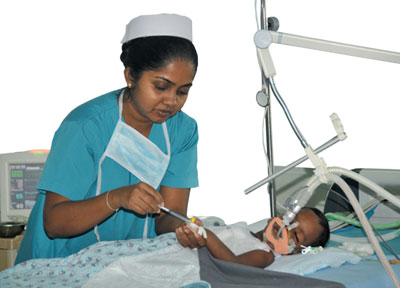 |
|
A nurse caring
for one of the twins |
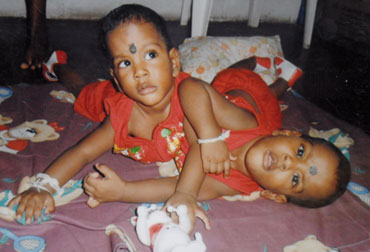 |
|
Before separation |
For Champika and her husband Amith, of Pitabeddara, Matara it was the
happiest time of their life, a time to dream beautiful dreams. They
yearned for a token of their love to symbolise the special bond they
shared. To have healthy babies, to hold, cuddle and grow old together
watching them grow!
Finally 25-year-old Champika showed signs that her dream was about to
come true. Her bulging belly and changing appearance got Amith to get
closer to and love her even more. Their happiness doubled with yet more
surprising news - they were going to have twins. The expectant mother
and father were elated.
A routine ultrasound scan was scheduled when Champika was five months
into her pregnancy. This is when the bombshell was dropped.
Consultant VOG at Mahamodara Dr. K. Gunaratna came out clean. "You
have a very unique case. The babies inside you have not completely
separated. You will be giving birth to conjoined twins."
No one can be prepared to brace the shock of such news. That was the
last thing they wanted to hear - their babies were not alright. "I felt
my heart stop," the mother said. "We could not explain the pain we
felt." They grappled unsuccessfully to come to terms with reality.
Champika attended the regular maternity clinic at Karapitiya Teaching
Hospital. But soon after the discovery of her condition, she was
referred to the Castle Street Maternity Hospital in Colombo, a
specialised Gynaecological and Obstetric hospital with the capacity to
handle special cases of pregnancy such as Champika's.
Their life became a constant struggle from then onwards. They had to
attend clinics at Castle Street Hospital which is over 150 kilometres
away from their home town in Matara. Despite the shocking news, the
mother and father were determined to do whatever possible to bring their
babies to this world as healthy as they could be. She followed the
doctor's advice to the letter, to keep them strong within the warmth of
her womb.
|
Team of surgeons
Paediatric
Surgeons
Dr.B.A.D.Jayawardena Dr.Ranjan Dias
Dr. Malick Samarasinghe
Heart and
Thoracic Surgeon
Dr.Kanchana Singappuli
Anaesthetists
Dr.Sunil Wijesooriya
Dr.Daya Perera
Dr.Seetha Alwis
Dr.Anoma Perera |
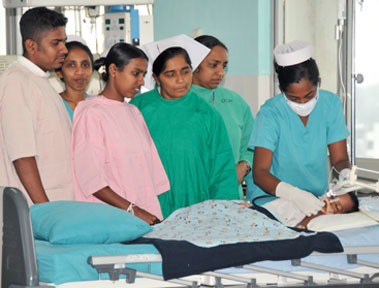 |
|
At the surgical ICU.
Champika and Amith are on left |
Champika got herself admitted to Castle Street Hospital well in
advance of the due date, as per the medical advice to deliver her
'different babies'. Each day of the pregnancy brought new fears and
nightmares. She hoped from deep within for doctors to be wrong.
Finally, the day dawned. She gave birth to two beautiful sons.
Together they weighed 4.2 kg. The identical twins vowed not to let go
even after birth, their bodies were fastened together. The two appeared
as if they had just one tummy.
Champika's heart sank.
The doctors, after medical examinations said the twins shared one
liver. Some 'layers' of the' heart wall' (Pericardium) were also common
to both. But luckily they had two hearts. Soon after birth the babies
were transferred to the Lady Ridgeway Hospital for children in Borella.
The doctors and nurses at the special care unit of the LRH began
treatment. Her babies must be at least nine months old to undergo
surgery to separate them, Champika learned from the doctors there.
The staff at the LRH accommodated the mother in the hospital. She
received special training to tend to her new born babies.
For three months their life was spent at the LRH. After three months
Amith rented a small house at Narahenpita. To be near his wife and the
babies he had to live in Colombo. He was jobless by this time and
without an income.
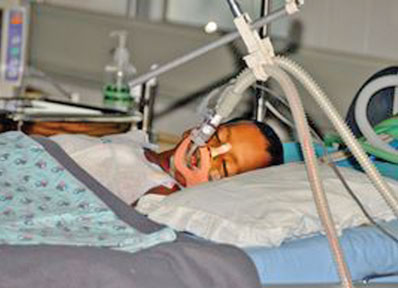 |
|
Deneth and Denuwan
after separation |
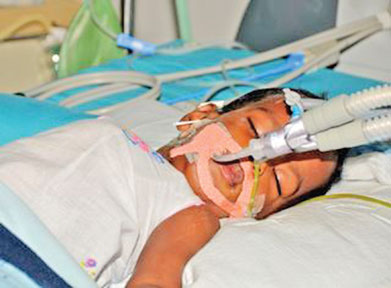 |
Their families had been an enormous strength and the two grandmothers
and an aunt took turns in looking after their new born grandchildren
until they were fit enough for surgery.
According to the mother despite their awkward position, they grew up
as normal babies. "They even wanted to turn and crawl like ordinary
babies do."
On January 10, 2011, a special three-member team of paediatric
surgeons, one heart and thoracic surgeon and a team of four
anaesthetists assisted by a 25-member senior Nursing and other staff
prepared for the historic moment.
The two babies, Deneth and Denuwan were to be separated. Doctors
deemed that the babies who weighed 10kg by then, were fit for
separation.
There had been a surgery at LRH before in 2006 to separate conjoined
twins, but it had not been a success. Amith and Champika said this was
the most gruesome moment of their ordeal. They found it difficult even
to breathe.
The babies were prepared and taken into the surgical theatre around
8.00 a.m.
The surgical team struggled with them for over six hours till around
2.30 p.m. Deneth and Denuwan who went inside as a single unit came out
as two individuals and occupied two separate beds in the Surgical ICU.
Although covered in numerous, different sized tubes and machines,
they both looked peaceful in their deep sleep. A day after the surgery
the media was allowed to see them from a distance.
A nursing sister attending to the babies who were recovering at the
Surgical Intensive Care Unit said the doctors did not have to
reconstruct bones in their bodies.
They were all intact. The liver had to be cut in half as they shared
this vital organ. The layers of the heart wall which they shared had to
be attended to and reconstructed.
The doctors believe Deneth and Denuwan are on the path to complete
recovery. But they are cautious to say anything more. Champika and Amith
heaved a sigh of relief with the happy news for which they anxiously
waited for the past 10 months.
The babies are still in the surgical ICU and the doctors said it was
too early to predict when the babies could be sent home with their
parents.
|
Highly remote
Dr. Hemantha Dodampahala,
Consultant Obstetrician and Gynaecologist at De Soysa
Maternity Hospital and Senior Lecturer of Feto-Maternal
Medicine of the Colombo Medical Faculty said every expectant
mother should not be paranoid of having Siamese twins
(conjoined) because the chances of such a birth is highly
remote.
"The chances of having
Siamese twins are about one percent of the births of
ordinary twins. The chances of pregnant mothers having twins
are about three percent of an ordinary birth."
But, Dr.Dodampahala said,
because of fertility treatment and IVF, there is an increase
in multiple pregnancies. As a result --- the incidents of
conjoined twins too have slightly gone up. But among the
ordinary mothers who have had no such treatment, the chance
of having a Siamese twin is highly remote.
"The Siamese twins are the
result of a partially separated fertilised egg. If the egg
is separated within the first ten days of fertilisation,
there is no issue. There will be two identical twins," he
said.
"Thanks to new inventions in
obstetrics and ultrasound we are able to diagnose such
conditions early in the pregnancy, as early as 10 weeks,
simply by observing if the foetuses share the same sex,
position and movements."
In the developed countries
all these babies are terminated in the early stages with the
permission of parents. But in Sri Lanka, the law does not
permit termination. So once it has been continued, the
paediatric surgeons will be entrusted to separate the
conjoined twins.
Not all twins are difficult
to separate. Only those who share vital organs and major
blood vessels will be difficult to separate. The babies
joined in the chest will not be difficult to separate if
they do not share a single heart. Those who are linked from
head can also be separated without much difficulty if they
don't share a single brain. "Overall I feel this is not a
pregnancy that should be
continued," Dr. Dodampahala added. |
|

